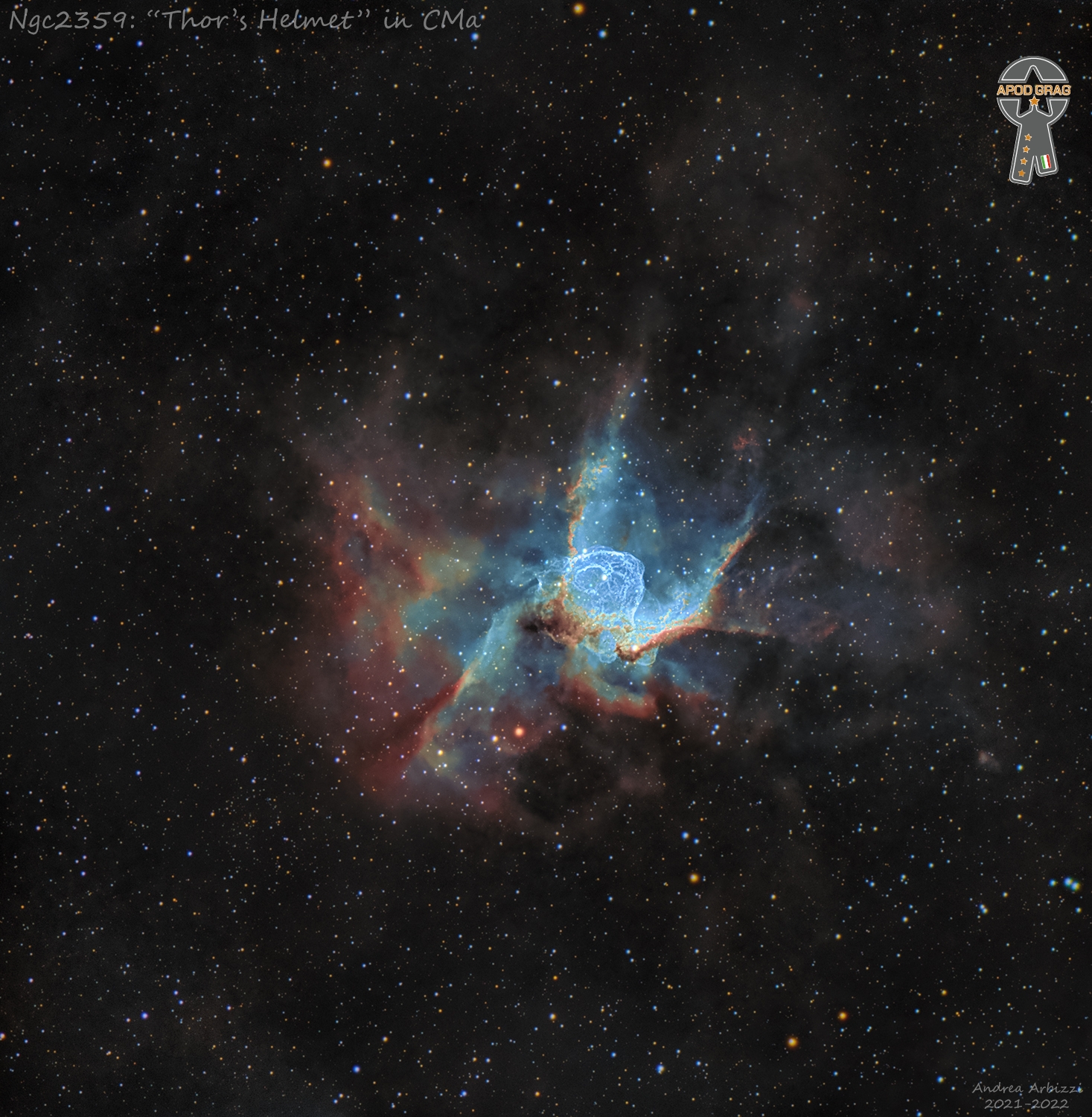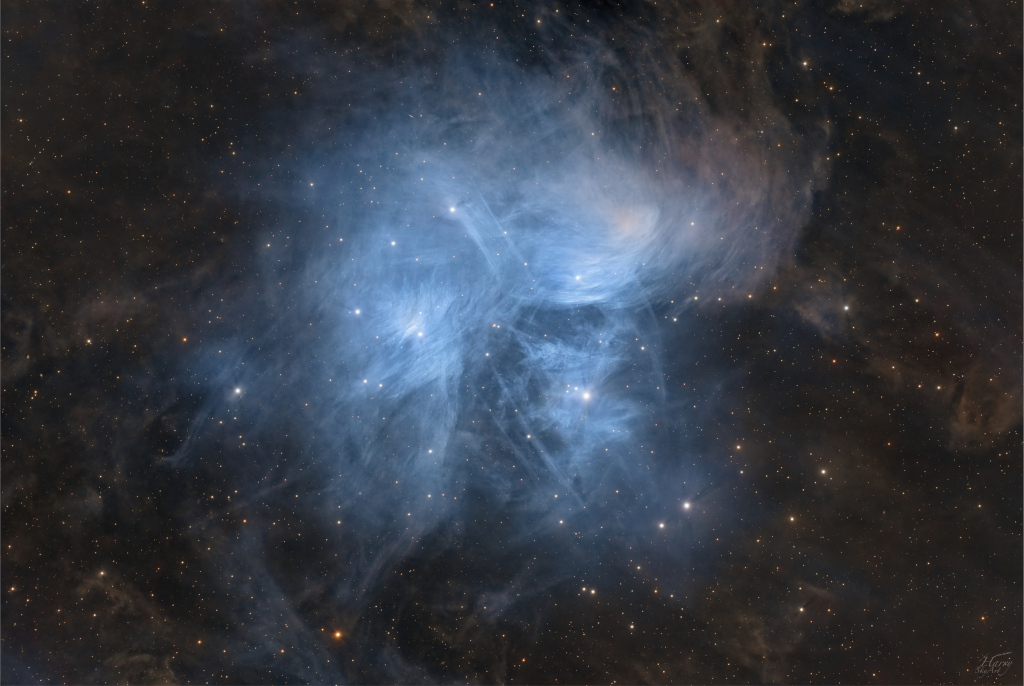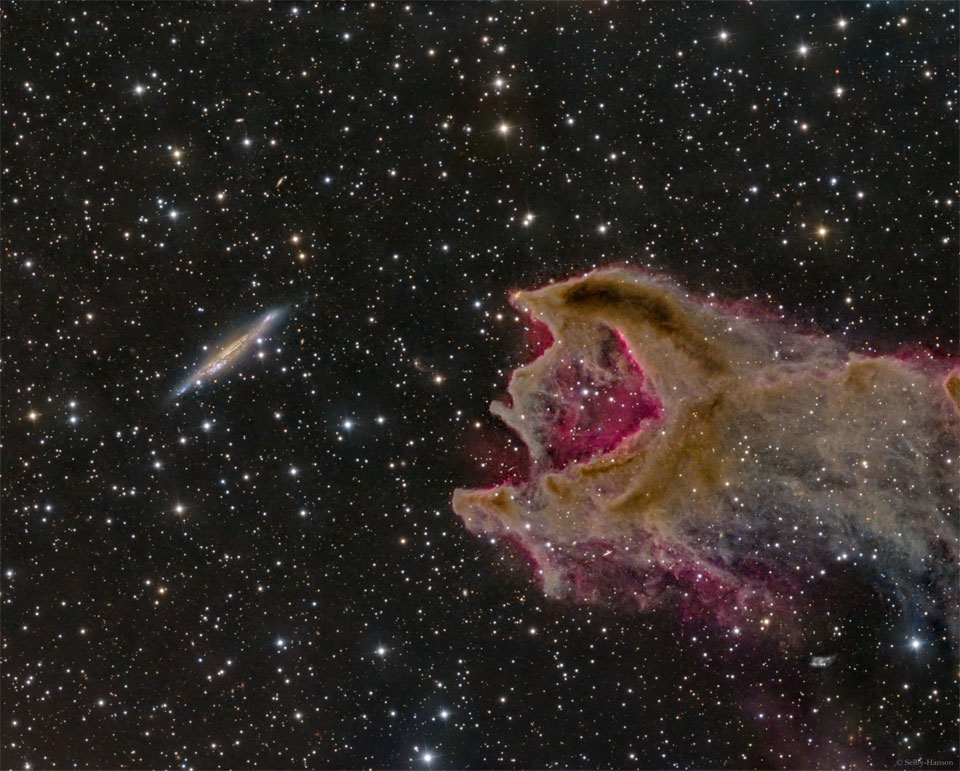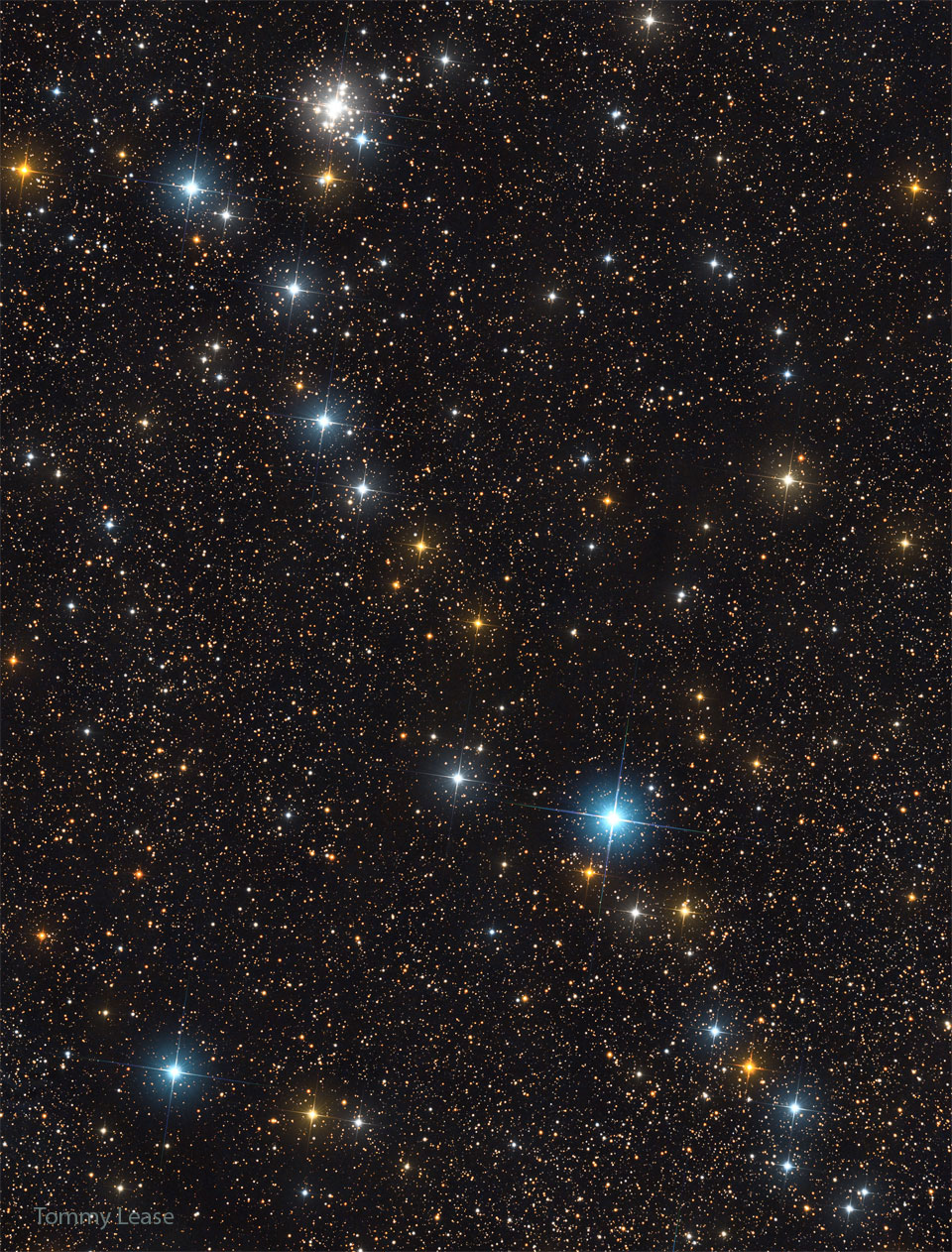Blog
NGC 2359 (also known as Thor’s Helmet) is an emission nebula in the constellation Canis Major. The nebula is approximately 3,670 parsecs (11.96 thousand light years) away and 30 light-years in size. The central star is the Wolf-Rayet star WR7, an extremely hot star thought to be in a brief pre-supernova stage of evolution. It is similar in nature to the Bubble Nebula, but interactions with a nearby large molecular cloud are thought to have contributed to the more complex shape and curved bow-shock structure of Thor’s Helmet. It is also catalogued as Sharpless 2-298 and Gum 4.

more...
Alexandra Elene MacLean Denny (6 January 1947 – 21 April 1978) was an English singer who was lead singer of the British folk rock band Fairport Convention. She has been described as “the pre-eminent British folk rock singer”.
After briefly working with the Strawbs, Denny joined Fairport Convention in 1968, remaining with them until 1969. She formed the short-lived band Fotheringay in 1970, before focusing on a solo career. Between 1971 and 1977, Denny released four solo albums: The North Star Grassman and the Ravens, Sandy, Like an Old Fashioned Waltz and Rendezvous. She also duetted with Robert Plant on “The Battle of Evermore” for Led Zeppelin‘s album Led Zeppelin IV in 1971. Denny died in 1978 at the age of 31 due to injuries and health issues related to alcohol abuse.
Music publications Uncut and Mojo have described Denny as Britain’s finest female singer-songwriter. Her composition “Who Knows Where the Time Goes?” has been recorded by Judy Collins, Eva Cassidy, Nina Simone, 10,000 Maniacs and Cat Power. Her recorded work has been the subject of numerous reissues, along with a wealth of previously unreleased material which has appeared over the more than 40 years since her death, including a 19-CD box set released in November 2010.
In January 2023, Denny was ranked #164 on Rolling Stone‘s list of the 200 Greatest Singers of All Time. At 7:50 pm on 21 April 1978, Sandy Denny died, without regaining consciousness. Her death was ruled to be the result of a traumatic mid-brain haemorrhage and blunt force trauma to her head. She was 31 years old.
more...
Ebo Taylor (born 1936) is a Ghanaian guitarist, composer, bandleader, record producer and arranger focusing on highlife and afrobeat music.
Ebo Taylor has been a pivotal figure on the Ghanaian music scene for over six decades. In the late 1950s he was active in the influential highlifebands the Stargazers and the Broadway Dance Band. In 1962, Taylor took his group, the Black Star Highlife Band, to London. In London, Taylor collaborated with Nigerian afrobeat star Fela Kuti as well as other African musicians in Britain at the time.
Returning to Ghana, Taylor worked as a producer, crafting recordings for Pat Thomas, C. K. Mann, and others, as well as exploring solo projects, combining traditional Ghanaian material with afrobeat, jazz, and funk rhythms to create his own recognizable sound in the 1970s. He was the in house guitar player, arranger, and producer for Essiebons, founded by Dick Essilfie-Bondzie.
more...Earl Eugene Scruggs (January 6, 1924 – March 28, 2012 Cleveland County, North Carolina) was an American musician noted for popularizing a three-finger banjo picking style, now called “Scruggs style“, which is a defining characteristic of bluegrass music. His three-finger style of playing was radically different from the traditional way the five-string banjo had previously been played. This new style of playing became popular and elevated the banjo from its previous role as a background rhythm instrument to featured solo status. He popularized the instrument across several genres of music.
Scruggs’ career began at age 21 when he was hired to play in Bill Monroe‘s band, the Blue Grass Boys. The name “bluegrass” eventually became the eponym for the entire genre of country music now known by that title. Despite considerable success with Monroe, performing on the Grand Ole Opryand recording classic hits such as “Blue Moon of Kentucky“, Scruggs resigned from the group in 1946 because of their exhausting touring schedule. Fellow band member Lester Flatt resigned as well, and he and Scruggs later paired up in the duo Flatt and Scruggs. Scruggs’ banjo instrumental, “Foggy Mountain Breakdown“, was released in 1949 and became an enduring hit. The song experienced a rebirth of popularity to a younger generation when it was featured in the 1967 film Bonnie and Clyde. The song won two Grammy Awards and, in 2005, was selected for the Library of Congress’ National Recording Registry of works of unusual merit.
Flatt and Scruggs brought bluegrass music into mainstream popularity in the early 1960s with their country hit, “The Ballad of Jed Clampett“—the theme music for the television sitcom The Beverly Hillbillies—the first Scruggs recording to reach number one on the Billboard charts. Over their 20-year association, Flatt and Scruggs recorded over 50 albums and 75 singles. The duo broke up in 1969, chiefly because, while Scruggs wanted to switch styles to fit a more modern sound, Flatt was a traditionalist who opposed the change and believed doing so would alienate a fan base of bluegrass purists. Although each of them formed a new band to match their visions, neither of them ever regained the success they had achieved as a team.
Scruggs received four Grammy awards, a Grammy Lifetime Achievement Award and a National Medal of Arts. He became a member of the International Bluegrass Music Hall of Fame and was given a star on the Hollywood Walk of Fame. In 1985, Flatt and Scruggs were inducted together into the Country Music Hall of Fame and named, as a duo, number 24 on CMT‘s “40 Greatest Men of Country Music”. Scruggs was awarded a National Heritage Fellowship by the National Endowment for the Arts, the highest honor in the folk and traditional arts in the United States. Four works by Scruggs have been placed in the Grammy Hall of Fame. After Scruggs’ death in 2012 at age 88, the Earl Scruggs Center was founded in Shelby, North Carolina, near his birthplace with the aid of a federal grant and corporate donors. The center is a $5.5 million facility that features the musical contributions of Scruggs and serves as an educational center providing classes and field trips for students.
more...Yiannis Papaioannou (Greek: Ιωάννης Ανδρέου Παπαιωάννου; 6 January 1910, Kavala – 19 May 1989, Athens) was a Greek composer and teacher of the Modern Era. He studied piano with Marika Laspopoulou and composition with Alekos Kontis at the Hellenic Conservatory in Athens(1922–34), as well as the piano and orchestration with Emilios Riadis in Thessaloniki (1928–29).
In 1949 he visited major European music centres on a UNESCO grant and became familiar with new developments in music composition. In particular, in Paris he attended Arthur Honegger’s class. Between 1951 and 1961 he taught music at an Athens high school and from 1953 he was professor of counterpoint and composition at the Hellenic Conservatory. He was the first president of both the Greek section of the International Society for Contemporary Music (1964–75) and the Hellenic Association for Contemporary Music (1965–75).
Papaioannou was the first musician to systematically teach atonal, 12-note and serial techniques before 1970. His compositional career falls into five main phases: Early Impressionist (1932–8), National School (1939–43), Hindemithian neo-classicism combined with elements of Byzantine music(1944–52), 12-note period (1953–1966) and the last period (1966–89) in which he developed an entirely personal technique.
more...The structure of solea is more flexible and open to interpretation than either alegria or sevillana, but there are nonetheless common structures and passages you’re likely to encounter when accompanying a dancer. Common arrangements include:
- Introduction & Temple
- First Copla & First Falseta
- Redoblao
- Second Copla & Second Falseta
- Escobilla
- Transition to Buleria and Ending
You should experiment with moving these pieces around and fitting them to each other in new ways. As with the alegria, sections can be rearranged, doubled, or eliminated altogether.
The compas of solea is based in 12s and, like alegria, is accented on the 3, 6, 8, 10, and 12 beats:
1 2 3 4 5 6 7 8 9 10 11 12
more...Hurtling through a cosmic dust cloud a mere 400 light-years away, the lovely Pleiades or Seven Sisters open star cluster is well-known for its striking blue reflection nebulae. It lies in the night sky toward the constellation Taurus and the Orion Arm of our Milky Way galaxy. The sister stars are not related to the dusty cloud though. They just happen to be passing through the same region of space. Known since antiquity as a compact grouping of stars,Galileo first sketched the star cluster viewed through his telescope with stars too faint to be seen by eye. Charles Messier recorded the position of the cluster as the 45th entry in his famous catalog of things which are not comets. In Greek myth, the Pleiades were seven daughters of the astronomical titan Atlas and sea-nymph Pleione. Their parents names are included in the cluster’s nine brightest stars. This well-processed, color-calibrated telescopic image features pin-point stars and detailed filaments of interstellar dust captured in over 9 hours of exposure. It spans more than 20 light-years across the Pleiades star cluster.

more...
Wilbert Huntington Harrison (January 5, 1929 – October 26, 1994) was an American rhythm and blues singer, pianist, guitarist and harmonica player.
Born in Charlotte, North Carolina, Harrison had a Billboard #1 record in 1959 with the song “Kansas City“. The song was written in 1952 and was one of the first credited collaborations by the team of Jerry Leiber and Mike Stoller. It sold over one million copies, and was awarded a gold disc. Harrison recorded “Kansas City” for the Harlem-based entrepreneur Bobby Robinson, who released it on his Fury record label.
At the height of the song’s success, Robinson was sued by Savoy Records who informed them that the release of the record in March 1959 violated a contract Harrison had with that label that was to expire in August 1959. The litigation, which lasted until September 1959, abruptly prevented Robinson from issuing follow-ups to “Kansas City” while Harrison was a star.
more...Paul Wertico (born January 5, 1953 in Chicago, Illinois) is an American drummer. He gained recognition as a member of the Pat Metheny Group from 1983 until 2001, leaving the group to spend more time with his family and to pursue other musical interests.
After Pat Metheny heard the Simon and Bard Group with Wertico and bassist Steve Rodby, he invited both to join his band. During his time with Metheny, Wertico played on ten albums and four videos, appeared on television, and toured around the world. He won seven Grammy Awards (for “Best Jazz Fusion Performance,” “Best Contemporary Jazz Performance,” and “Best Rock Instrumental Performance”), magazine polls, and received several gold records.
He formed the Paul Wertico Trio with John Moulder and Eric Hochberg and collaborated with Larry Coryell, Kurt Elling, and Jeff Berlin. From 2000 to 2007, he was a member of SBB, the platinum-record-winning Polish progressive rock band. Wertico was a member of the Larry Coryell Power Trio until Coryell’s death in 2017.
In 2009, Wertico became a member of the jazz-rock group Marbin with Israeli musicians Danny Markovitch and Dani Rabin. The group performed as Paul Wertico’s Mid-East/Mid-West Alliance and recorded an album for the Chicago Sessions label that received accolades from the Chicago Tribune, DRUM!, and Modern Drummer.
more...Alvin Ailey Jr. (January 5, 1931 – December 1, 1989) was an American dancer, director, choreographer, and activist who founded the Alvin Ailey American Dance Theater (AAADT). He created AAADT and its affiliated Alvin Ailey American Dance Center (later Ailey School) as havens for nurturing Black artists and expressing the universality of the African-American experience through dance.
A gay man, his work fused theater, modern dance, ballet, and jazz with Black vernacular, creating hope-fueled choreography that continues to spread global awareness of Black life in America. Ailey’s choreographic masterpiece Revelations is recognized as one of the most popular and most performed ballets in the world.
On July 15, 2008, the United States Congress passed a resolution designating AAADT a “vital American cultural ambassador to the World.” That same year, in recognition of AAADT’s 50th anniversary, then Mayor Michael Bloomberg declared December 4 “Alvin Ailey Day” in New York City, while then-Governor David Paterson honored the organization on behalf of New York State.
more...Elizabeth “Libba” Cotten (née Nevills; January 5, 1893 – June 29, 1987) was an American folk and blues musician. She was a self-taught left-handed guitarist who played a guitar strung for a right-handed player, but played it upside down. This position meant that she would play the bass lines with her fingers and the melody with her thumb. Her signature alternating bass style has become known as “Cotten picking”.
Cotten was born in 1893 to a musical family near Chapel Hill, North Carolina, in an area that would later be incorporated as Carrboro. Her parents were George Nevill (also spelled Nevills) and Louisa (or Louise) Price Nevill. Elizabeth was the youngest of five children. She named herself on her first day of school, when the teacher asked her name, because at home she was only called “Li’l Sis”.
more...
The “claw” of this odd looking “creature” in the featured photo is a gas cloud known as a cometary globule. This globule, however, has ruptured. Cometary globules are typically characterized by dusty heads and elongated tails. These features cause cometary globules to have visual similarities to comets, but in reality they are very much different. Globules are frequently the birthplaces of stars, and many show very young stars in their heads. The reason for the rupture in the head of this object is not yet known. The galaxy to the left of the globule is huge, very far in the distance, and only placed near CG4 by chance superposition.

more...
John McLaughlin (born 4 January 1942), frequently known as Mahavishnu John, is an English guitarist, bandleader, and composer. A pioneer of jazz fusion, his music combines elements of jazz with rock, world music, Indian classical music, Western classical music, flamenco, and blues. After contributing to several key British groups of the early 1960s, McLaughlin made Extrapolation, his first album as a bandleader, in 1969. He then moved to the U.S., where he played with drummer Tony Williams‘s group Lifetime and then with Miles Davis on his electric jazz fusion albums In a Silent Way, Bitches Brew, Jack Johnson, and On the Corner. His 1970s electric band, the Mahavishnu Orchestra, performed a technically virtuosic and complex style of music that fused electric jazz and rock with Indian influences.
McLaughlin’s solo on “Miles Beyond” from his album Live at Ronnie Scott’s won the 2018 Grammy Award for the Best Improvised Jazz Solo. He has been awarded multiple “Guitarist of the Year” and “Best Jazz Guitarist” awards from magazines such as DownBeat and Guitar Player based on reader polls. In 2003, he was ranked 49th in Rolling Stone magazine’s list of the “100 Greatest Guitarists of All Time“. In 2009, DownBeat included McLaughlin in its unranked list of “75 Great Guitarists”, in the “Modern Jazz Maestros” category. In 2012, Guitar World magazine ranked him 63rd on its top 100 list. In 2010, Jeff Beck called McLaughlin “the best guitarist alive”, and Pat Metheny has also described him as the world’s greatest guitarist. In 2017, McLaughlin was awarded an honorary doctorate of music from Berklee College of Music.
more...Frank Wellington Wess (January 4, 1922 – October 30, 2013) was an American jazz saxophonist and flutist. In addition to his extensive solo work, Wess is remembered for his time in Count Basie‘s band from the early 1950s into the 1960s. Critic Scott Yanow described him as one of the premier proteges of Lester Young, and a leading jazz flutist of his era—using the latter instrument to bring new colors to Basie’s music.
Wess was born in Kansas City, Missouri, United States, the son of a principal father and a schoolteacher mother. He began with classical music training and played in Oklahoma in high school. He later switched to jazz on moving to Washington, D.C. and by nineteen was working with big bands. His career was interrupted by World War II although he did play with a military band in the period. After leaving the military, he joined Billy Eckstine‘s orchestra. He returned to Washington D.C. a few years afterwards and received a degree in flute at the city’s Modern School of Music. He played tenor sax with Count Basie from 1953 to 1964, doubling on flute.
more...A little too faint to see with the unaided eye, Kemble’s Cascade of stars inspires awe when seen with binoculars. Like the Big Dipper though, Kemble’s Cascade is an asterism, not a constellation. The asterism is visible in the northern sky toward the long-necked constellation of the Giraffe (Camelopardalis). This string of about 20 unrelated stars, each of similar brightness, spans over five times the angular width of the full moon. Stretching diagonally from the upper left to the lower right, Kemble’s Cascade was popularized last century by astronomy enthusiast Lucian Kemble. The bright object near the top left of the image is the relatively compact Jolly Roger open cluster of stars, officially designated as NGC 1502.

More Posts
- World Music with Gamelon Cudamani
- Daily Roots with Dennis Brown
- The Cosmos with NGC 6589
- Isaac Hayes Day
- Frank Rosolino Day
- Jimmy Raney Day
- World Music with Ortega, Silveira and Elizarde
- Daily Roots with Nicodemus
- The Cosmos with NGC 2371/2
- Johnny Nash Day
- Jimmy Rowles Day
- World Music with Ebo Taylor
- Daily Roots with Horace Martin
- World Music with Faran Ensemble
- Rhythm Roots Workshop Drum Gathering 8-18-19
- The Cosmos with Sagittarius A*
- Sonny Til Day
- Enoch Light Day
- Antonio Salieri Day
- Daily Roots with George Allison